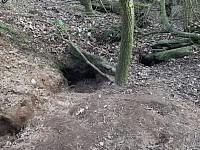Sett Surveying
The essential information for anyone attempting to protect badgers is to know where they live, their sett and to update that information whenever possible.
There are four categories of badger sett
Main Sett - normally a substantial number of entrances providing access to a complex of tunnels which in turn lead to wider points, know as chambers, where the badgers actually rest.
Annex Sett - as the name implies, this is a similar complex to the Main Sett and close to it but without underground connection possibly because of a physical obstruction.
Secondary Sett - yet another underground complex located some distance from the Main Sett and at certain times of the year could display all the signs of being a main sett.
Outlier Sett - a simple structure with a single entrance normally accessing a short tunnel and chamber, usually well away from the larger setts and often near the boundary of the clan territory.
Sett surveys can be triggered by incidents such as the discovery of orphaned cubs or a road casualty but can also be organised in a more structured way to search areas where there are no records of setts but that particular piece of countryside seems to offer ideal badger habitat.
Regular pre-planned surveys are also important to re-check known setts for any change in their level of occupation and to look for signs of damage or more serious abuse.
Detailed surveys are the essential initial action in badger vaccination schemes and survey records are often important to enable us to comment on planning applications and to recommend with confidence any additional protection measures that may be needed.
Surveying Courses are offered by various organisations but the simple fact is that they are unable to impart, in a couple of days, any more knowledge and expertise than can be gathered by regularly joining experienced badger group members.
Techniques vary but it’s always important to consider what nature is doing at any given time of the year. For instance there is little point in surveying when there is snow on the ground unless it’s part of an attempt to locate orphaned cubs nor is there any point in surveying rough areas in late Spring into early Summer when the growth of vegetation such as brambles and nettles is at its peak.
These sort of issues are what makes surveying interesting and challenging, alongside plenty of exercise, fresh air and the company of like minded people.

